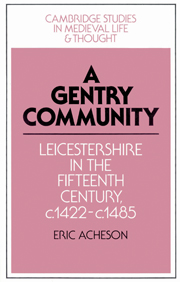Book contents
- Frontmatter
- Contents
- List of maps
- Acknowledgements
- Abbreviations
- Introduction
- 1 Leicestershire: the county, the Church, the crown and the nobility
- 2 The gentry in the fifteenth century
- 3 Land and income
- 4 A county community and the politics of the shire
- 5 The gentry and local government, 1422–1485
- 6 Household, family and marriage
- 7 Life and death
- Conclusion
- Appendices
- Bibliography
- Index
- Titles in the series
6 - Household, family and marriage
Published online by Cambridge University Press: 27 October 2009
- Frontmatter
- Contents
- List of maps
- Acknowledgements
- Abbreviations
- Introduction
- 1 Leicestershire: the county, the Church, the crown and the nobility
- 2 The gentry in the fifteenth century
- 3 Land and income
- 4 A county community and the politics of the shire
- 5 The gentry and local government, 1422–1485
- 6 Household, family and marriage
- 7 Life and death
- Conclusion
- Appendices
- Bibliography
- Index
- Titles in the series
Summary
Just as the gentry are often seen as the political pawns of their social superiors, the nobility, so too has the gentry family been presented as subject to the external agencies of the wider kin and the ‘good lord’. Any treatment of the attitudes, concerns and ambitions of the Leicestershire gentry must therefore necessarily consider the more intimate aspects of their lives. It must deal with the household which provided the setting for family life itself and the relationships formed within it between husband and wife and between parents and children, and with the ties of kinship which bound one gentry family to another. Throughout this chapter our major concern will be with the extent to which the personal lives of the gentry were, indeed, subservient to external agencies.
The setting for family life was, of course, the household. Unfortunately, private correspondence, diaries and the more important domestic account books which can provide such valuable material about the size and organization of gentry homes have not survived for Leicestershire. Nevertheless, light may be thrown on gentry households by looking first at the manor houses which contained them. While the finest remaining examples of fifteenth-century secular architecture in the county were built by lord Hastings at Ashby de la Zouch and Kirby Muxloe, only fragments of the relatively less grand gentry houses now stand as testimony to their own former dignity.
- Type
- Chapter
- Information
- A Gentry CommunityLeicestershire in the Fifteenth Century, c.1422–c.1485, pp. 135 - 173Publisher: Cambridge University PressPrint publication year: 1992



